
|
|
Differential Frequently Asked Questions

Sergeant Clutch Discount Differential Repair Shop in San Antonio, Texas provides the following Differential FAQ’s and Differential Tips that may help you avoid problems, unnecessary expense, maximize your automobiles fuel efficiency and most importantly keep you and your family safe while on the road.
For many people getting a drivers license is an event that is second only to getting a diploma or marriage license. Unfortunately most drivers don’t know the first thing about the automobiles they drive and this can turn a ticket to freedom into a ticket to trouble or expensive repairs. If you’re like most drivers you probably tend to drive around until something goes wrong an then incur the expense of replacing worn and broken parts. A little maintenance could keep you on the road longer. Review your Automobiles Owners Manual. Not every automobile is the same and its important to know what your automobiles manufacture recommends when it comes to periodic maintenance.
Always keep records of repairs and services for your automobile. This will give your mechanic a snap shot of the automobiles history and it may help generate a higher resale value. Your automobile is one of your biggest investments and whether you have a newer model with state of the art computerized systems, or an older automobile, regular maintenance is necessary to your automobile in top running condition.
Sergeant Clutch Discount Differential Repair Shop tries to anticipate Differential FAQ’s you might have about Repair, Products and Services. If you spend 15 minutes a month to do an under the hood inspection you can prevent 70% of the problems that lead to breakdowns. The goal of this monthly inspection is keeping your automobile from breaking down on the road, to catch minor problems before they become major expenses , to prevent premature wear and tear.
Don’t try to diagnose the problem unless you are qualified. Sergeant Clutch Discount Differential Repair Shop employs professional mechanics that understand your automobile. If your not mechanically inclined good news. With over 60 Years Experience in the Differential Repair Repair Industry Sergeant Clutch Discount Differential in San Antonio is "The Under The Hood Expert". Our Team of Hardworking Certified Automotive Mechanics and Differential Mechanics specialize in Complete Automobile Repair and Service from Domestic, Foreign, Automatic, Manual, Front Wheel Drive, Rear Wheel Drive, Four Wheel Drive, All Wheel Drive, Car, Truck, Suv, 4x4, Bus, RV.


|
|
|
|
A differential is a device, usually but not necessarily employing gears, capable of transmitting torque and rotation through three shafts, almost always used in one of two ways: in one way, it receives one input and provides two outputs. This is found in most automobiles and in the other way, it combines two inputs to create an output that is the sum, difference, or average, of the inputs.
In automobile and other wheeled vehicles, the differential allows each of the driving road wheels to rotate at different speeds, while for most vehicles supplying equal torque to each of them.
A vehicle's wheels rotate at different speeds, mainly when turning corners. The differential is designed to drive a pair of wheels with equal torque while allowing them to rotate at different speeds. In vehicles without a differential, such as karts, both driving wheels are forced to rotate at the same speed, usually on a common axle driven by a simple chain-drive mechanism. When cornering, the inner wheel needs to travel a shorter distance than the outer wheel, so with no differential, the result is the inner wheel spinning and / or the outer wheel dragging, and this results in difficult and unpredictable handling, damage to tires and roads, and strain on or possible failure of the entire drivetrain.
The following description of a differential applies to a "traditional" rear-wheel-drive car or truck with an "open" or limited slip differential:
Torque is supplied from the engine, via the transmission, to a drive shaft (British term: 'propeller shaft', commonly and informally abbreviated to 'prop-shaft'), which runs to the final drive unit that contains the differential. A spiral bevel pinion gear takes its drive from the end of the propeller shaft, and is encased within the housing of the final drive unit. This meshes with the large spiral bevel ring gear, known as the crown wheel. The crown wheel and pinion may mesh in hypoid orientation, not shown. The crown wheel gear is attached to the differential carrier or cage, which contains the 'sun' and 'planet' wheels or gears, which are a cluster of four opposed bevel gears in perpendicular plane, so each bevel gear meshes with two neighbors, and rotates counter to the third, that it faces and does not mesh with. The two sun wheel gears are aligned on the same axis as the crown wheel gear, and drive the axle half shafts connected to the vehicle's driven wheels. The other two planet gears are aligned on a perpendicular axis which changes orientation with the ring gear's rotation. In the two figures shown above, only one planet gear (green) is illustrated, however, most automotive applications contain two opposing planet gears. Other differential designs employ different numbers of planet gears, depending on durability requirements. As the differential carrier rotates, the changing axis orientation of the planet gears imparts the motion of the ring gear to the motion of the sun gears by pushing on them rather than turning against them (that is, the same teeth stay in the same mesh or contact position), but because the planet gears are not restricted from turning against each other, within that motion, the sun gears can counter-rotate relative to the ring gear and to each other under the same force (in which case the same teeth do not stay in contact).
Thus, for example, if the car is making a turn to the right, the main crown wheel may make 10 full rotations. During that time, the left wheel will make more rotations because it has further to travel, and the right wheel will make fewer rotations as it has less distance to travel. The sun gears (which drive the axle half-shafts) will rotate in opposite directions relative to the ring gear by, say, 2 full turns each (4 full turns relative to each other), resulting in the left wheel making 12 rotations, and the right wheel making 8 rotations.
The rotation of the crown wheel gear is always the average of the rotations of the side sun gears. This is why, if the driven roadwheels are lifted clear of the ground with the engine off, and the drive shaft is held (say leaving the transmission 'in gear', preventing the ring gear from turning inside the differential), manually rotating one driven roadwheel causes the opposite roadwheel to rotate in the opposite direction by the same amount.
When the vehicle is traveling in a straight line, there will be no differential movement of the planetary system of gears other than the minute movements necessary to compensate for slight differences in wheel diameter, undulations in the road (which make for a longer or shorter wheel path), etc.
One undesirable side effect of a conventional differential is that it can reduce over torque the rotational force that propels the vehicle. The amount of torque required to propel the vehicle at any given moment depends on the load at that instant—how heavy the vehicle is, how much drag and friction there is, the gradient of the road, the vehicle's momentum, and so on. For the purpose of this article, we will refer to this amount of torque as the "threshold torque".
The torque applied to each driving road wheel is a result of the engine and transmission applying a twisting force against the resistance of the traction at that roadwheel. Unless the load is exceptionally high, the engine and transmission can usually supply as much torque as necessary, so the limiting factor is usually the traction under each wheel. It is therefore convenient to define traction as the amount of torque that can be generated between the tire and the road surface, before the wheel starts to slip. If the total traction under all the driven wheels exceeds the threshold torque, the vehicle will be driven forward; if not, then one or more wheels will simply spin.
To illustrate how a differential can limit overall torque, imagine a simple rear wheel drive vehicle, with one rear roadwheel on asphalt with good grip, and the other on a patch of slippery ice. With the load, gradient, etc., the vehicle requires, say, 2,000 newton metres (1,480 ft·lbf) of torque to move forward (i.e. the threshold torque). Let us further assume that the non-spinning traction on the ice equates to 400 N·m (300 ft·lbf), and the asphalt to 3,000 N·m (2,210 ft·lbf).
If the two roadwheels were driven without a differential, each roadwheel would be supplied with an equal amount of torque, and would push against the road surface as hard as possible. The roadwheel on ice would quickly reach the limit of traction (400 Nm), but would be unable to spin because the other roadwheel has good traction. The traction of the asphalt plus the small extra traction from the ice exceeds the threshold requirement, so the vehicle will be propelled forward.
With a differential, however, as soon as the "ice wheel" reaches 400 Nm, it will start to spin, and then develop less traction ~300 Nm. The planetary gears inside the differential carrier will start to rotate because the "asphalt wheel" encounters greater resistance. Instead of driving the asphalt wheel with more force, the differential will still symmetrically split the total amount of available torque equally. ~300 Nm is sufficient to make the ice wheel to spin, but the equal amount of ~300 Nm is not enough to turn the asphalt wheel. Since the asphalt wheel remains stationary, the spinning ice wheel will rotate twice as fast as before. As the actual torque on both roadwheels is the same—the amount is determined by the lesser traction of the ice wheel. So both wheels will get 300 Nm each. Since 600 Nm is less than the required threshold torque of 2000 Nm, the vehicle will not be able to utilise the output from the engine, and will not move.
An observer will simply see one stationary roadwheel on one side of the vehicle, and one spinning roadwheel on the opposite side. It will not be obvious that both wheels are generating the same torque (i.e. both wheels are in fact pushing equally, despite the difference in rotational speed). This has led to a widely held misconception that a vehicle with a differential is really only "one-wheel-drive". In fact, a normal differential always allows the transmission of equal torque to both driven roadwheels; unless it is a specific type of differential, such as locking, torque-biasing, or limited slip type.
A proposed way to distribute the power to the wheels, is to use the concept of gearless differential, of which a review has been reported by Provatidis, but the various configurations seem to correspond either to the "sliding pins and cams" type, such as the ZF B-70 available for early VWs, or are a variation of the ball differential.
There are various devices for getting more usable traction from vehicles with differentials.
One solution is the limited slip differential (LSD), the most well-known of which is the clutch-type LSD. With this differential, the side gears are coupled to the carrier via a multi-disc clutch which allows extra torque to be sent to the wheel with high resistance than available at the other driven roadwheel when the limit of friction is reached at that other wheel. Below the limit of friction more torque goes to the slower (inside) wheel. If there is no load on one wheel then no torque goes to the other so the LSD provides no torque except for spring loading, but some extra effect can be obtained by partially applying the vehicle's parking brake when one roadwheel is spinning, as this can provide some resistance there to increase the overall torque, and allow the other driven roadwheel to move the vehicle. This only works where the handbrake acts on the driven wheels, as in the traditional rear wheel drive layout. Naturally, the handbrake should be released as soon as the vehicle is moving again.
A locking differential, such as ones using differential gears in normal use but using air or electrically controlled mechanical system, which when locked allow no difference in speed between the two wheels on the axle. They employ a mechanism for allowing the planetary gears to be locked relative to each other, causing both wheels to turn at the same speed regardless of which has more traction; this is equivalent to effectively bypassing the differential gears entirely. Other locking systems may not even use differential gears but instead drive one wheel or both depending on torque value and direction. 4WD vehicles without a centre differential should not be driven on dry, paved roads in four-wheel drive mode, as small differences in rotational speed between the front and rear wheels cause a torque to be applied across the transmission. This phenomenon is known as "wind-up", and can cause considerable damage to the transmission or drive train. On loose surfaces these differences are absorbed by the tire slippage on the road surface. A transfer case may also incorporate a centre differential, allowing the drive shafts to spin at different speeds. This permits the four-wheel drive vehicle to drive on paved surfaces without experiencing "wind-up".
A high-friction 'Automatic Torque Biasing' (ATB) differential, such as the Torsen differential, where the friction is between the gear teeth rather than at added clutches. This applies more torque to the driven roadwheel with highest resistance (grip or traction) than is available at the other driven roadwheel when the limit of friction is reached at that other wheel. When tested with the wheels off the ground, if one wheel is rotated with the differential case held, the other wheel will still rotate in the opposite direction as for an open differential but there with be some frictional losses and the torque will be distributed at other than 50/50. Although marketed as being "torque-sensing", it functions the same as a limited slip differential.
A very high-friction differential, such as the ZF "sliding pins and cams" type, so that there is locking from very high internal friction. When tested with the wheels off the ground with torque applied to one wheel it will lock, but it is still possible for the differential action to occur in use, albeit with considerable frictional losses, and with the road loads at each wheel in opposite directions rather than the same (acting with a "locking and releasing" action rather than a distributed torque).
An additional function of the conventional electronic traction control systems usually use the anti lock braking system (ABS) roadwheel speed sensors to detect a spinning roadwheel, and apply the brake to that wheel. This progressively raises the reaction torque at that roadwheel, and the differential compensates by transmitting more torque through the other roadwheel—the one with better traction. In Volkswagen vehicles, this specific function is called 'Electronic Differential Lock' (EDL).
In a four wheel drive vehicle, a viscous coupling unit can replace a centre differential entirely, or be used to limit slip in a conventional 'open' differential. It works on the principle of allowing the two output shafts to counter-rotate relative to each other, by way of a system of slotted plates that operate within a viscous fluid, often silicone. The fluid allows slow relative movements of the shafts, such as those caused by cornering, but will strongly resist high-speed movements, such as those caused by a single wheel spinning. This system is similar to a limited slip differential.
A four-wheel drive (4WD) vehicle will have at least two differentials one in each axle for each pair of driven roadwheels, and possibly a centre differential to apportion torque between the front and rear axles. In some cases the centre differential is an epicyclic differential to divide the torque asymmetrically, but at a fixed rate between the front and rear axle. Other methods utilise an 'Automatic Torque Biasing' (ATB) centre differential, such as a Torsen which is what Audi use in their Quattro cars with longitudinal engines.
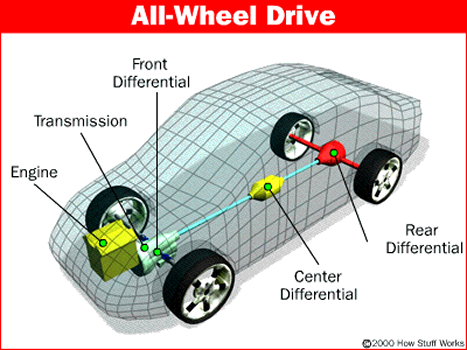
San Antonio Differential Repair Shop Sergeant Clutch Discount Differential & Rear End Repair Shop In San Antonio Offers Differential Repair and Differential Services Differential Maintenance, Differential Oil Change, Differential Reseal Repair, Differential Minor Repair, Differential Overhaul Repair, Differential Rebuild Repair, New Differential Replacement, Used Differential Replacement, Remanufactured Differential Replacement, Performance Differential Upgrades, Heavy Duty Differential Upgrades, FREE Differential Performance Check, FREE Rear End Performance Check
Sergeant Clutch Discount Differential Repair Shop
6557 Walzem Rd. San Antonio, Texas 78239
Call Us 24 Hours 210-239-1600

|
|
|
What Is An Epicyclic Differential?
|
The input shaft is the green hollow one, the yellow is the low torque output, and the pink is the high torque output. The force applied in the yellow and the pink gears is the same, but since the arm of the pink one is 2× to 3× as big, the torque will be 2× to 3× as high.
An epicyclic differential uses epicyclic gearing to split and apportion torque asymmetrically between the front and rear axles. An epicyclic differential is at the heart of the Toyota Prius automotive drive train, where it interconnects the engine, motor-generators, and the drive wheels which have a second differential for splitting torque as usual. It has the advantage of being relatively compact along the length of its axis that is, the sun gear shaft.
Epicyclic gears are also called planetary gears because the axes of the planet gears revolve around the common axis of the sun and ring gears that they mesh with and roll between. In the image, the yellow shaft carries the sun gear which is almost hidden. The blue gears are called planet gears and the pink gear is the ring gear or annulus.
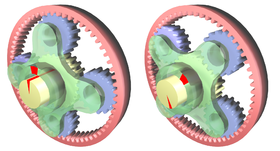
San Antonio Differential Repair Shop Sergeant Clutch Discount Differential & Rear End Repair Shop In San Antonio Offers Differential Repair and Differential Services Differential Maintenance, Differential Oil Change, Differential Reseal Repair, Differential Minor Repair, Differential Overhaul Repair, Differential Rebuild Repair, New Differential Replacement, Used Differential Replacement, Remanufactured Differential Replacement, Performance Differential Upgrades, Heavy Duty Differential Upgrades, FREE Differential Performance Check, FREE Rear End Performance Check
Sergeant Clutch Discount Differential Repair Shop
6557 Walzem Rd. San Antonio, Texas 78239
Call Us 24 Hours 210-239-1600

|
|
|
What Is A Spur Gear Differential?
|
This is another type of differential that was used in some early automobiles, more recently the Oldsmobile Toronado, as well as other non-automotive applications. It consists of spur gears only.
A spur-gear differential has two equal-sized spur gears, one for each half-shaft, with a space between them. Instead of the Bevel gear, also known as a miter gear, assembly the "spider" at the centre of the differential, there is a rotating carrier on the same axis as the two shafts. Torque from a prime mover or transmission, such as the drive shaft of a car, rotates this carrier.
Mounted in this carrier are one or more pairs of identical pinions, generally longer than their diameters, and typically smaller than the spur gears on the individual half-shafts. Each pinion pair rotates freely on pins supported by the carrier. Furthermore, the pinions pairs are displaced axially, such that they mesh only for the part of their length between the two spur gears, and rotate in opposite directions. The remaining length of a given pinion meshes with the nearer spur gear on its axle. Therefore, each pinion couples that spur gear to the other pinion, and in turn, the other spur gear, so that when the drive shaft rotates the carrier, its relationship to the gears for the individual wheel axles is the same as that in a bevel-gear differential.
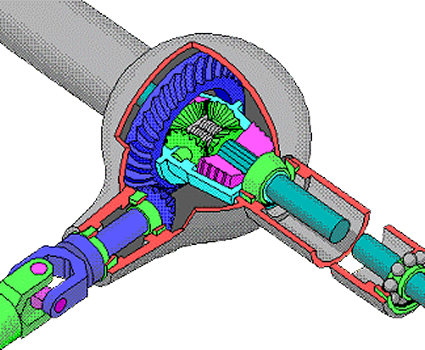
San Antonio Differential Repair Shop Sergeant Clutch Discount Differential & Rear End Repair Shop In San Antonio offers
Differential Repair and Differential Services Differential Maintenance, Differential Oil Change, Differential Reseal Repair, Differential Minor Repair, Differential Overhaul Repair, Differential Rebuild Repair, New Differential Replacement, Used Differential Replacement, Remanufactured Differential Replacement, Performance Differential Upgrades, Heavy Duty Differential Upgrades, FREE Differential Performance Check, FREE Rear End Performance Check
Sergeant Clutch Discount Differential Repair Shop
6557 Walzem Rd. San Antonio, Texas 78239
Call 24 Hours 210-239-1600

|
|
|
What Is The Purpose Of A Differential?
|
A vehicle's wheels rotate at different speeds, mainly when turning corners. The differential is designed to drive a pair of wheels with equal torque while allowing them to rotate at different speeds. In vehicles without a differential, such as karts, both driving wheels are forced to rotate at the same speed, usually on a common axle driven by a simple chain-drive mechanism. When cornering, the inner wheel needs to travel a shorter distance than the outer wheel, so with no differential, the result is the inner wheel spinning and / or the outer wheel dragging, and this results in difficult and unpredictable handling, damage to tires and roads, and strain on or possible failure of the entire drivetrain.
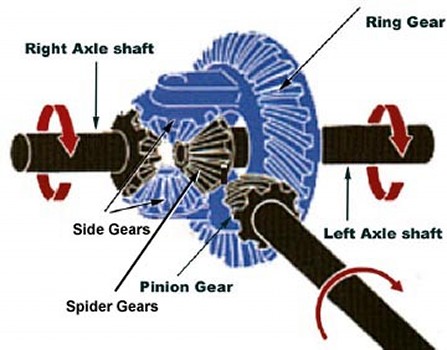
San Antonio Differential Repair Shop Sergeant Clutch Discount Differential & Rear End Repair Shop In San Antonio Offers Differential Repair and Differential Services Differential Maintenance, Differential Oil Change, Differential Reseal Repair, Differential Minor Repair, Differential Overhaul Repair, Differential Rebuild Repair, New Differential Replacement, Used Differential Replacement, Remanufactured Differential Replacement, Performance Differential Upgrades, Heavy Duty Differential Upgrades, FREE Differential Performance Check, FREE Rear End Performance Check
Sergeant Clutch Discount Differential Repair Shop
6557 Walzem Rd. San Antonio, Texas 78239
Call 24 Hours 210-239-1600

|
|
|
What Is A Limited Slip Differential?
|
A limited slip differential (LSD) is a type of differential gear arrangement that allows for some difference in angular velocity of the output shafts, but imposes a mechanical bound on the disparity. In an automobile, such limited slip differentials are sometimes used in place of a standard differential, where they convey certain dynamic advantages, at the expense of greater complexity.
The main advantage of a limited slip differential is shown by considering the case of a standard or "open" differential where one wheel has no contact with the ground at all. In such a case, the contacting wheel will remain stationary, and the non-contacting wheel will rotate freely. The torque transmitted will be equal at both wheels, but will not exceed the threshold of torque needed to move the vehicle, and thus the vehicle will remain stationary. In everyday use on typical roads, such a situation is very unlikely, and so a normal differential suffices. For more demanding use, such as driving in mud, off road, or for high performance vehicles, such a state of affairs is undesirable, and the LSD can be employed to deal with it. By limiting the angular velocity difference between a pair of driven wheels, useful torque can be transmitted as long as there is some traction available on at least one of the wheels.
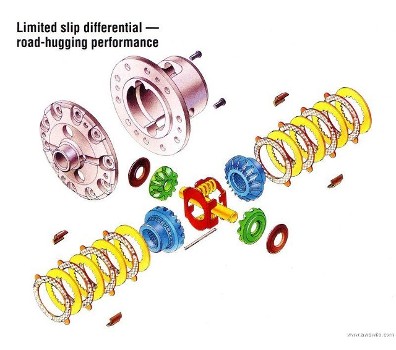
San Antonio Differential Repair Shop Sergeant Clutch Discount Differential & Rear End Repair Shop In San Antonio Offers Differential Repair and Differential Services Differential Maintenance, Differential Oil Change, Differential Reseal Repair, Differential Minor Repair, Differential Overhaul Repair, Differential Rebuild Repair, New Differential Replacement, Used Differential Replacement, Remanufactured Differential Replacement, Performance Differential Upgrades, Heavy Duty Differential Upgrades, FREE Differential Performance Check, FREE Rear End Performance Check
Sergeant Clutch Discount Differential Repair Shop
6557 Walzem Rd. San Antonio, Texas 78239
Call 24 Hours 210-239-1600

|
|
|
What Is A Locking Differential?
|
A locking differential, diff-lock or locker is a variation on the standard automotive differential. A locking differential may provide increased traction compared to a standard, or "open" differential by restricting each of the two wheels on an axle to the same rotational speed without regard to available traction or differences in resistance seen at each wheel.
A locking differential is designed to overcome the chief limitation of a standard open differential by essentially "locking" both wheels on an axle together as if on a common shaft. This forces both wheels to turn in unison, regardless of the traction or lack thereof available to either wheel individually.
When the differential is unlocked open differential, it allows each wheel to rotate at different speeds (such as when negotiating a turn), thus avoiding tire scuffing. An open or unlocked differential always provides the same torque (rotational force) to each of the two wheels, on that axle. So although the wheels can rotate at different speeds, they apply the same rotational force, even if one is entirely stationary, and the other spinning. Equal torque, unequal rotational speed.
By contrast, a locked differential forces both left and right wheels on the same axle to rotate at the same speed under nearly all circumstances, without regard to tractional differences seen at either wheel. Therefore, each wheel can apply as much rotational force as the traction under it will allow, and the torques on each side-shaft will be unequal. Unequal torque, equal rotational speeds.
A locked differential can provide a significant traction advantage over an open differential, but only when the traction under each wheel differs significantly.
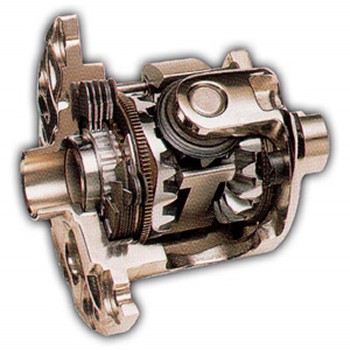
San Antonio Differential Repair Shop Sergeant Clutch Discount Differential & Rear End Repair Shop In San Antonio Offers Differential Repair and Differential Services Differential Maintenance, Differential Oil Change, Differential Reseal Repair, Differential Minor Repair, Differential Overhaul Repair, Differential Rebuild Repair, New Differential Replacement, Used Differential Replacement, Remanufactured Differential Replacement, Performance Differential Upgrades, Heavy Duty Differential Upgrades, FREE Differential Performance Check, FREE Rear End Performance Check
Sergeant Clutch Discount Differential Repair Shop
6557 Walzem Rd. San Antonio, Texas 78239
Call 24 Hours 210-239-1600

|
|
|
Will Servicing My Differential Help It Last Longer?
|
Yes servicing your car or trucks differential regularly can dramatically extend its life and enhance it performance. That’s because the differential fluid does more than just lubricate and cool the internal differential parts: It also helps drive it. Damage to the differential fluid, such as oxidation and shear, will reduce the differential holding power and life. Old worn out differential fluid allows the differential to slip, overheat and can quickly cause it to fail. To keep your differential working longer, you should have it serviced regularly. Regular differential fluid services will add miles and years to your differentials life.
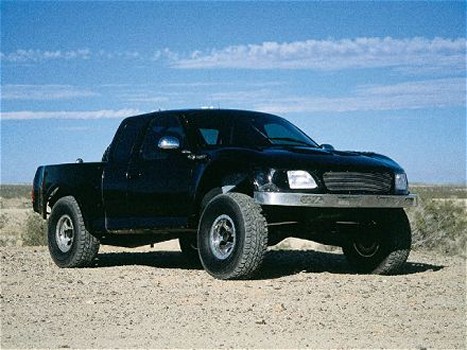
San Antonio Differential Repair Shop Sergeant Clutch Discount Differential & Rear End Repair Shop In San Antonio Offers Differential Repair and Differential Services Differential Maintenance, Differential Oil Change, Differential Reseal Repair, Differential Minor Repair, Differential Overhaul Repair, Differential Rebuild Repair, New Differential Replacement, Used Differential Replacement, Remanufactured Differential Replacement, Performance Differential Upgrades, Heavy Duty Differential Upgrades, FREE Differential Performance Check, FREE Rear End Performance Check
Sergeant Clutch Discount Differential Repair Shop
6557 Walzem Rd. San Antonio, Texas 78239
Call Us 24 Hours 210-239-1600

|
|
|
Why Is My Differential Making Noise?
|
Noises in your differential can be caused by several things. The differential noise could be something inside the differential, or it could be something outside the differential. Differential noises should be checked as soon as possible. Properly operating differentials do not make any noises. A noise inside the differential could indicate a problem. By identifying the differential problem early could help prevent costly damage to your differential.

San Antonio Differential Repair Shop Sergeant Clutch Discount Differential & Rear End Repair Shop In San Antonio Offers Differential Repair and Differential Services Differential Maintenance, Differential Oil Change, Differential Reseal Repair, Differential Minor Repair, Differential Overhaul Repair, Differential Rebuild Repair, New Differential Replacement, Used Differential Replacement, Remanufactured Differential Replacement, Performance Differential Upgrades, Heavy Duty Differential Upgrades, FREE Differential Performance Check, FREE Rear End Performance Check
Sergeant Clutch Discount Differential Repair Shop
6557 Walzem Rd. San Antonio, Texas 78239
Call Us 24 Hours 210-239-1600

|
|
|
How Long Will It Take To Repair My Vehicle?
|
The length downtime depends on the type of repair being performed, shop scheduling and availability of all necessary parts. The Shop Manager will keep the customer informed of when a time of completion can be expected.
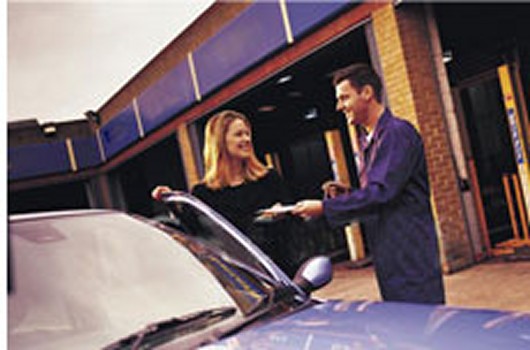
San Antonio Differential Repair Shop Sergeant Clutch Discount Differential & Rear End Repair Shop In San Antonio Offers Differential Repair and Differential Services Differential Maintenance, Differential Oil Change, Differential Reseal Repair, Differential Minor Repair, Differential Overhaul Repair, Differential Rebuild Repair, New Differential Replacement, Used Differential Replacement, Remanufactured Differential Replacement, Performance Differential Upgrades, Heavy Duty Differential Upgrades, FREE Differential Performance Check, FREE Rear End Performance Check
Sergeant Clutch Discount Differential Repair Shop
6557 Walzem Rd. San Antonio, Texas 78239
Call 24 Hours 210-239-1600

|
|
|
|
 |


